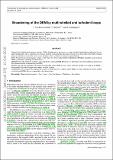Files in this item
Broadening of the differential emission measure by multi-shelled and turbulent loops
Item metadata
| dc.contributor.author | Van Doorsselaere, Tom | |
| dc.contributor.author | Antolin, Patrick | |
| dc.contributor.author | Karampelas, Kostas | |
| dc.date.accessioned | 2018-10-18T10:30:06Z | |
| dc.date.available | 2018-10-18T10:30:06Z | |
| dc.date.issued | 2018-12 | |
| dc.identifier.citation | Van Doorsselaere , T , Antolin , P & Karampelas , K 2018 , ' Broadening of the differential emission measure by multi-shelled and turbulent loops ' , Astronomy & Astrophysics , vol. 620 , A65 . https://doi.org/10.1051/0004-6361/201834086 | en |
| dc.identifier.issn | 0004-6361 | |
| dc.identifier.other | PURE: 256246816 | |
| dc.identifier.other | PURE UUID: 5c448413-6e7d-4cce-a67c-c3b27add3d9f | |
| dc.identifier.other | BibCode: 2018arXiv181006300V | |
| dc.identifier.other | Scopus: 85057741120 | |
| dc.identifier.other | WOS: 000452370900001 | |
| dc.identifier.uri | https://hdl.handle.net/10023/16275 | |
| dc.description | Funding: UK Science and Technology Facilities Council (Consolidated Grant ST/K000950/1), the European Union Horizon 2020 research and innovation programme (grant agreement No. 647214) and STFC Ernest Rutherford Fellowship (grant agreement No. ST/R004285/1) (PA). | en |
| dc.description.abstract | Context. Broad differential emission measure (DEM) distributions in the corona are a sign of multi-thermal plasma along the line-of-sight.Traditionally, this is interpreted as evidence of multi-stranded loops. Recently, however, it has been shown that multi-stranded loops are unlikely to exist in the solar corona, because of their instability to transverse perturbations. Aims. We aim to test if loop models subject to the Transverse Wave-Induced Kelvin-Helmholtz (TWIKH) instability result in broad DEMs, potentially explaining the observations. We took simulation snapshots and compute the numerical DEM. Moreover, we performed forward-modelling in the relevant AIA channels before reconstructing the DEM. Results. We find that turbulent loop models broaden their initial DEM, because of the turbulent mixing. The width of the DEM is determined by the initial temperature contrast with the exterior. Conclusions. We conclude that impulsively excited loop models have a rather narrow DEM, but that continuously driven models result in broad DEMs that are comparable to the observations. | |
| dc.format.extent | 7 | |
| dc.language.iso | eng | |
| dc.relation.ispartof | Astronomy & Astrophysics | en |
| dc.rights | © 2018, ESO. This work has been made available online in accordance with the publisher’s policies. This is the author created accepted version manuscript following peer review and as such may differ slightly from the final published version. The final published version of this work is available at https://www.aanda.org/ | en |
| dc.subject | Magnetohydrodynamics | en |
| dc.subject | Sun: corona | en |
| dc.subject | Sun: oscillations | en |
| dc.subject | Turbulence | en |
| dc.subject | Instabilities | en |
| dc.subject | QB Astronomy | en |
| dc.subject | QC Physics | en |
| dc.subject | T-NDAS | en |
| dc.subject.lcc | QB | en |
| dc.subject.lcc | QC | en |
| dc.title | Broadening of the differential emission measure by multi-shelled and turbulent loops | en |
| dc.type | Journal article | en |
| dc.contributor.sponsor | Science & Technology Facilities Council | en |
| dc.contributor.sponsor | European Research Council | en |
| dc.contributor.sponsor | Science & Technology Facilities Council | en |
| dc.description.version | Postprint | en |
| dc.contributor.institution | University of St Andrews. Applied Mathematics | en |
| dc.identifier.doi | https://doi.org/10.1051/0004-6361/201834086 | |
| dc.description.status | Peer reviewed | en |
| dc.identifier.url | http://adsabs.harvard.edu/abs/2018arXiv181006300V | en |
| dc.identifier.grantnumber | ST/K000950/1 | en |
| dc.identifier.grantnumber | 647214 | en |
| dc.identifier.grantnumber | ST/R004285/1 | en |
This item appears in the following Collection(s)
Items in the St Andrews Research Repository are protected by copyright, with all rights reserved, unless otherwise indicated.

